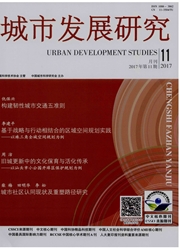

 中文摘要:
中文摘要:
城市空间与居民行为有着密不可分的内在联系,活动分析法(Activity-based Approach)是将时间与空间、活动与移动、选择与制约结合起来分析人类行为的有效手段。基于出行链(Tour-based)分析思想,以2007年北京城市居民活动日志调查数据为基础,运用Logistic回归模型和次序Logit模型对居民工作日出行的多目的性、交通方式机动化程度的决策影响因素进行分析。结果表明,个人社会经济属性对居民出行链的决策具有显著的影响;随着居住空间由中心向外缘扩展,居民出行的多目的性增加、机动化程度提高,扩展至五环以外有所回落;活动时间、移动时间、出行距离对出行链的多目的化、交通工具机动化具有正向影响,晚高峰的机动化程度较高。
 英文摘要:
英文摘要:
Urban space has a symbiotic relationship with transportation,and activity-based approach is a powerful method to integrate three key problems of human behavior research: the colligation of time and space,the behavioral mechanism of choice and constraints, the links between activity and travel. The primary purpose of this paper was to investigate relative associations between behavioral patterns of urban residents and their socio-economic attributes and residential locations. By using a tour-based modeling framework and highly detailed activity diary data collected in Beijing,2007,this paper focuses on activity-travel behavior in workdays. A logistic regression model of multi-purpose tour in the whole day is estimated first. Then,ordered logit model ( OLM ) of travel mode motorization is developed and estimated. Empirical results indicate that travel decisions are significantly affected by demographic factors,such as employment and income. Full-time employment has more complex tours,and an increase in income would result in travel motorization. Residential location is a significant predictor of travel choice. From the downtown to the suburb,residents have the propensity to generate multi-purpose tours with more stops per tour and choose higher motorized travel modes. Especially,residents living around the fourth and fifth ring roads encounter the highest level of space-time constraints. Some alternative attributes,including activity time,travel time and travel distance,have positive influence on tour complexity and travel motorization. Motorized tours seem to generate at rush hours regularly,which results in traffic problems. This paper discusses historical contexts and institutional factors in China’s cities to interpret the results in order to provide scientific consults to public policy.
 同期刊论文项目
同期刊论文项目
 同项目期刊论文
同项目期刊论文
 期刊信息
期刊信息
